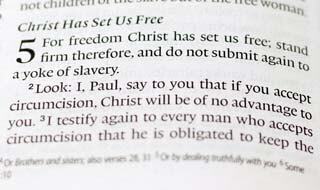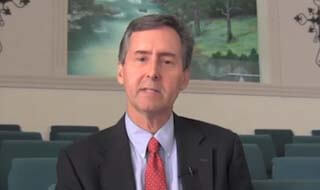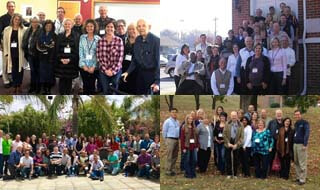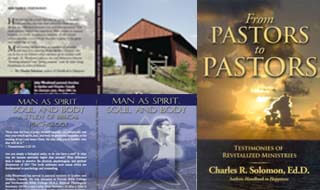A DEFENSE OF TRICHOTOMY
Responses to Common Objections to Trichotomy
Before concluding this study, the question needs to be faced: are the arguments against trichotomy unanswerable? Although some of these challenges have been indirectly addressed above, there needs to be an additional response to the criti-cisms of trichotomy. Below is a composite list of challenges followed by a brief response for each.
The first objection to be considered is that Scripture uses “soul” and “spirit” interchangeably. This is the primary objection to trichotomy by most evangelical dichotomists. It is thought that the significant overlap in these terms requires the interpretation that they are only synonyms of man’s immaterial part. That “soul” and “spirit” share many meanings is readily conceded. The present writer judges that the distinction between these terms can be supported, but not proven in the Old Testament text alone. This is due to the nature of progressive revelation. The obvious distinction between body and soul is unclear in the concrete style of Hebrew thought and language, how much less should we expect a definitive case to be made in the Old Testament for the subtle distinctions between the soul and spirit. If this admission seems to jeopardize the proposition of this paper, consider Berkhof’s comment about the lack
93
of decisive evidence for dichotomy in the Old Testament alone:
We should be careful, however, not to expect the latter distinction between the body as the material element, and the soul as the spiritual element of human nature, in the Old Testament. This antithesis–soul and body–even in its New Testament sense, is not yet found in the Old Testament.154
The personal nature of the Holy Spirit as a member of the triune Godhead was not explicitly revealed in the Old Testament; it should not be surprising that the distinctive role of the human spirit would require New Testament revelation as well.
There are several examples of the similar usage of soul and spirit that are used as evidence against trichotomy: they both can be troubled (John 12:27; 13:21); they both can be involved in worship (Luke 1:46,47); they both can be objects of salvation (Jas 1:21; 1 Cor 5:5); they both are involved in thinking (Acts 14:2; 1 Cor 2:11); and they both are used with “body” to describe the whole person (Matt 10:28; Jas 2:6). These and other examples are given to prove that the terms are used interchangeably. These examples only document that the terms have a significant overlap; often a biblical writer conveys his point by using either term, with the appropriate connotation. This overlap of meanings does not dictate that an identical part of man is described by either term. This rebuttal is further supported by the following observations: (a) Nephesh is sometimes used to describe a dead body, yet this does not prove that the soul and body are not distinct parts of man (Num 6:6; Lev 24:18); (b) The Spirit of Christ and the Holy Spirit are both titles of the third person
94
of the trinity–this does not equate the Son and the Spirit (Rom 8:11; 1 Cor 3:16); (c) Both animals and humans have nephesh–this does not invalidate man’s distinctive quality of soul which is necessitated by his creation in God’s image (Gen 1:24; 2:19). Overlap in word usage of soul and spirit does not prove a singular identity.
Another example used in the case for the interchangea-bility of the terms is their use as relating to salvation. The soul is saved (Heb 10:39) and the spirit is saved (1 Cor 5:5). Although this could be explained as another example of synec-doche, it may point to a more detailed model of salvation in the epistles. The body of a converted person is not credited with its new privileges until the resurrection; believers are “. . . eagerly waiting for the adoption, the redemption of our body” (Rom 8:23). On the other hand, salvation is described as an accomplished fact for the one who is regenerated (Eph 2:1-8); the spirit is one with God’s Spirit (1 Cor 6:17), Who “Himself bears witness with our spirit that we are children of God” (Rom 8:16). This may indicate that the soul is presently in the process of being saved (Jas 1:21: Ps 23:3). Thus, technically, the believer’s spirit is already saved from the penalty of sin, his soul is being saved from the power of sin, and his body will be saved from the presence of sin (at the resurrection–Phil 3:20,21). The New Testament confirms the need for the func-tional attributes of the believer’s soul to be progressively delivered from the influence of sin. The mind is to be renewed (Rom 12:2), the will is to be yielded (Luke 9:23), and the emotions are to be directed (Phil 4:4). Thus, the three aspects of salvation correlate with the parts of man.
95
In listing arguments against trichotomy, Grudem mentions the unity of man by describing the involvement of the body in virtually every activity of the soul. . . . We should not slip into the mistake of thinking that certain activities (such as thinking, feeling, or deciding things) are done by only one part of us. Rather, these activities are done by the whole person. When we think or feel things, certainly our physical bodies are involved in every point as well.155
His observation is a valid one. Yet, if the dichotomist affirms that every action involves both body and soul, he should not require an isolated action of the spirit as distinct from the soul. As an organ of the soul, the spirit is expressed through it. The criterion of requiring a function of the soul that does not have a counterpart in the physical organism could be used as an argument for monism (which Grudem rejects).
By syecdoche, the spirit can be used of the soul and often is (1 Cor 16:18; 2 Tim 4:22). This does not negate the distinction between them; the context determines the usage intended. As was shown in chapter two, several lexicons support the distinction of spirit from soul as more than one of conno-tation (e.g., Cremer, Thayer, Vines, and TWBOT). Similarly, the soul is often used to represent the whole person (although dichotomists concede that man is body and soul).
One of the distinctive qualities of the regenerated human spirit is that it is essentially holy–a partaker of God’s nature (2 Pet 1:4; 1 Cor 1:2; 6:17). Therefore, Paul can testify that he delights in the law of God in the inner man (Rom 7:22). An objection has been raised to this trichotomous
96
interpretation. 2 Cor 7:1 seems to indicate that the spirit can prompt sin: “Therefore, having these promises, beloved, let us cleanse ourselves from all filthiness of the flesh and spirit, perfecting holiness in the fear of God.” This may imply that the believer’s spirit has inherent sin too.
In response, the trichotomist reaffirms the basic unity of man’s personhood. The distinct role of the spirit as the part that primarily expresses God’s life in the believer, never removes responsibility from the spirit; man is unified in personhood and responsibility. But what is the precise nature of the spirit’s need for “cleansing”? The previous context gives a clue, describing the need for consecration. This practice alludes to the holiness concepts of the Old Testament. One of those concepts is the danger of defilement with unholy things, even if the Israelites were holy in themselves (Lev 21:1-14). Similarly, the believer must guard against the defilement of worldly values and demonic influences–both of which can still be understood as technically external to his spirit (Rom 12:2; Eph 6:10).
Another distinction of the spirit is that it usually describes the believer after physical death, although both soul and spirit stay together (Acts 23:8,9; Heb 12:23). This usage corresponds with what one would expect of man’s spirit in its primary relationship to God. The only New Testament exceptions (to referring to the intermediate state in terms of “spirit”) occur in Rev 6:9 and 20:4. In these passages the context is martyrdom; this shifts the emphasis to the bodily release of the immaterial part. It seems that this is the determining factor in the use of “soul” in these passages.
97
There are other distinctions in the New Testament usage of “spirit.” Beckwith and Oehler mention several: (a) the spirit does not die nor is killed; (b) the spirit is not the subject of inclination, or aversion; (c) whatever belongs to the spirit belongs to the soul also, but not everything that belongs to the soul belongs to the spirit as well (cf. the tabernacle analogy).156 Oehler further observed that the soul is used of the subject as personal and individual, but the spirit is not so used.157 Drawing on Gen 2:17 and Job 33:4 he specified that the soul exists and lives only by the vitalizing power of the spirit.158
In his extensive word study on pneuma , Schweiser noted that it is always used to contrast sarx in the unbeliever, never psuche; it is never used of non-Christians for impulses that are ethically negative; and it cannot be hated or persecuted as the soul can.159 Kerr observed that spirit does not hunger or thirst, although these physical functions are sometimes attributed to the soul. Some have noted that God is the “Father of spirits,” but never as the “Father of souls” (Heb 12: Zech 12:1). The observations in chapters two and four give further evidence of the distinction between soul and spirit.
98
Another objection made against trichotomy is this: if 1 Thes 5:23 is interpreted as referring to trichotomy, then Luke 10:27 teaches man has five parts. In the synoptic Gospels Christ quoted Deut 6:5 when He identified the greatest command-ment: “You shall love the LORD your God with all your heart, with all your soul, and with all your strength .” (cf. Matt 22:37; Mark 12:30; Luke 10:27). In the Gospels, “mind” is also included in this Great Commandment. In Matthew the preposition en is used to bring out the concept of instrumentality; (Perhaps this is why he inserts “mind” but leaves out “strength”). The heart includes soul and spirit; the soul includes the mind. The preposition used in Mark, (ek), denotes inwardness. The aspects of man from Deuteronomy plus “mind” are used for emphasis.160
How does this differ from other texts used to show the ontological distinction between soul and spirit? First, the incomplete and concrete style of the Old Testament language should be noted. Although the Gospel references are in the New Testament, the quoted revelation is Mosaic (which reflects its more less precise articulation of man’s inward parts). Waltke noted that the three terms,
. . . rather than signifying different spheres of biblical psychology seem to be semantically concentric. They were chosen to reinforce the absolute singularity of personal devotion to God.161
On the other hand, Paul’s intention in 1 Thes 5:23 is to specify the different aspects of man
99
that should be entirely sanctified. The importance of progressive revelation applies here also; Paul’s epistles give further clarity about the subtle differ-ences between soul and spirit. This New Testament epistle should be expected to give more advanced light on the immaterial parts of man than the Mosaic quotation did (cf. chapter four). 1 Thes 5:22 is not used as an isolated proof text; it is a confirming testimony that is uniquely important due to its place in the progressive revelation of the New Testament.
Trichotomy has also been challenged with the assertion that passages interpreted in support of trichotomy would necessarily contradict those that teach two parts of man.162 This argument assumes that trichotomy is of a crude sort that would contradict descriptions of the person as essentially material and immaterial. Such does not logically follow. Since the spirit is contained in the soul, a summary statement that only mentions two parts does not contradict ones that teach a third part. Passages that distinguish spirit from soul are presenting further detail and precision. A similar explanation is required to avoid some apparent discrepancies in Scripture. Examples of this principle of variance without contradiction can be found in the Gospels. Were there two angels at Christ’s empty tomb (Luke 24:4) or one (Matt 28:2)? Were there two demoniacs in Gadera (Matt 8:28) or one (Mark 5:2)? Where there two blind men healed at Jericho (Matt 20:30) or just Bartimaeus
100
(Mark 10:46)? In each case one writer gives less detail than the other. These differences in quantity of information do not require contradictions in Scripture. Similarly, texts that present man as body and soul do not contradict others that present the added detail of body, soul, and spirit.
It is objected that the Bible is ambiguous on whether man has two or three parts so the matter should be judged on rational grounds, which favors dichotomy.163 The rational grounds are said to favor dichotomy because of a lack of a conscious awareness of the spirit.164 This argument applied to anatomy would question the existence of an organ or part that a person could not see or feel. Whereas the observable techniques of science can prove the deficiency of this test, the question of the parts of man’s immaterial side must be decided on a different basis. Evidence has been presented above for inter-preting spirit as the organ of God-consciousness, and the soul as the organ of self-consciousness. Likewise, Rom 6-8 presents the detailed description of the conscious, internal struggle of the believer with his physical members (of the body), the flesh and the will (of the soul), and the law of God in the inner man (the spirit). Therefore, biblical revelation and the dynamics of one’s internal struggle can be understood better through a trichotomous model.
101
This argument against trichotomy is that, since “soul” is ascribed to God, therefore He can relate directly to man’s soul; the organ of spirit in man is unnecessary.165 One could challenge the proposition that God has a soul in a way similar to man’s soul. Although the word “soul” is used in relation to God (Jer 5:9; 6:8) this usage is rare and could be interpreted anthropomorphically. Similarly, God is said to have a hand, back, eyes, a right arm, etc., yet theologians do not deduce from these statements that God has a physical body (prior to the incarnation of the second person of the trinity). Rather, His essential nature is spirit (John 4:24) and He is materially invisible (1 Tim 1:17). Granted, God is a personal being Who has made man in His image. He does have mind, will, and emotions (which are functional attributes of the human soul), yet the application of redemption is primary the role of the Holy Spirit (cf. Rom 8:16; 1 Cor 6:17). The twenty six New Testament occurrences of the adjective “spiritual” (pneumatikos) as consistently positive and godward, confirm the scriptural evidence for man’s spirit as the primary organ for communion with the Holy Spirit.
A further reason for the avoidance of trichotomy is the opinion that it is prone to heretical views. On the other hand, dichotomy is said to be a safeguard against doctrinal errors. This argument may be the primary objection of many evangelical
102
dichotomists. It has been shown in chapter five that the heresy of Apollinaris brought trichotomy into disrepute; it has not yet fully recovered from this stigma. The western church found it easier to apply Occam’s razor and take the simpler view, i,e. man having only two parts. Strong is forthright in preferring dichotomy in order to automatically refute the following errors:
(a) That of the Gnostics, who held that the pneuma is part of the divine essence, and therefore incapable of sin. (b) That of the Appolinarians, who taught that Christ’s humanity embraced only soma and psuche , while his divine nature furnished the pneuma . (c) That of the Semi-Pelagians, who excepted the human pneuma from the dominion of original sin. (d) That of Placeus, who held that only the pneuma was directly created by God. (e) That of Julius Muller, who held that the psuche comes to us from Adam, but that our pneuma was corrupted in a previous state of being. (f) That of the Annihilationists, who hold that man at his creation had a divine element breathed into him, which he lost by sin, and which he recovers only at regeneration; so that only when he has this pneuma restored by virtue of his union with Christ does man become immortal, death being the to the sinner a complete extinction of being.166
Admittedly, dichotomists have the convenience of refuting these errors a priori due to eliminating the spirit as a distinct part of man. However, holistic trichotomy as presented in this paper would also condemn the heretical views just listed. It should also be noted that heretical views arise from monistic, and dichotomist models as well.167
This criticism of trichotomy is more a statement of preference than of veracity; it uses guilt-by-association. An example from church history can illustrate the problem inherent
103
in this approach. During the Reformation, the Anabaptist move-ment grew out of a commitment to evaluate traditional beliefs in the light of Scripture. Infant baptism was rejected in favor of believer’s baptism. However, the movement was quite divided and there were extreme views and practices such as the Munster revolt of 1534. John Matthys, an Anabaptist preacher, claimed himself Enoch, who would prepare for Christ’s return. His group took over this German town, proclaiming it the New Jerusalem, and enforced community-of-goods and polygamy were practiced. This episode affected the doctrinal preferences of the Lutherans. Walker noted, “Such fanaticism was popularly supposed to be characteristic of the Anabaptists, and the name became one of ignominy.”168 This was unfortunate, because the distinctives of believer’s baptism, an eagerness for the Second Advent, and the separation of church and state should have been judged by the Bible alone, not by aberrations. Likewise, heresies that incidentally have misrepresented the human spirit should not disqualify trichotomy.
Much of the criticism directed toward the distinction of body, soul, and spirit, is side-stepped when the spirit is not defined as a separable part of man, having a different essence than that of the soul. This writer by no means minimizes the academic credentials and intellectual depth of evangelical dichotomist theologians. The case for holistic trichotomy would be further strengthened were it not for the frequent ambiguity
104
in the Bible regarding spirit (as referring to either God’s or man’s). The responses above seek to demonstrate that trichotomy is based upon sound hermeneutics and is logically coherent. The final chapter will point out some practical implications for this model of man in Exchanged Life counseling.
154 Berkhof, Systematic Theology , 193.
155 Grudem, Systematic Theology, 476.
156 Beckwith, [NSHERK]”Biblical Conceptions of Soul and Spirit,” 12.
157 Gustav F. Oehler, Theology of the Old Testament (NY: Funk and Wagnalls, 1883), 152.
159 Gerhard Kittel and Gerhard Friedrich, eds., Theological Dictionary of the New Testament [TDNT](Grand Rapids: Eerdmans, 1964) s.v. “Psuche,” by Eduard Schweizer, 6: 649, 654-55.
160 Eduard Schweizer, “Psuche,” [TDNT], 6: 641.
161 Bruce Waltke [TWBOT], s.v. “Nephesh,” 2: 589.
162 Berkhof, Systematic Theology, 195.
163 Henry C. Sheldon, System of Christian Doctrine, (Boston: Carl H. Heintzemann, 1900), 274
164 Berkhof, Systematic Theology, 194.
165 Strong, Systematic Theology, 485.
166 Strong, Systematic Theology, 487.
167 For a survey of liberal and neo-orthodox views of the nature and functions of soul and spirit in man, see Agnes Sutherland, The Spiritual Dimensions of Personality (Philadelphia: Westminster Press, 1965).
168 Walker, A History of the Christian Church, 336.
by John Woodward

















